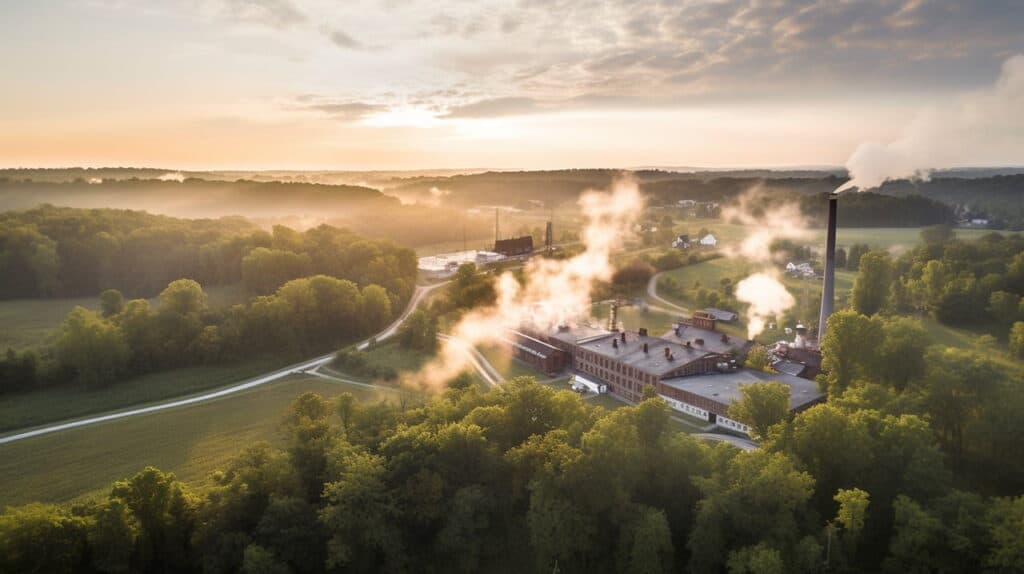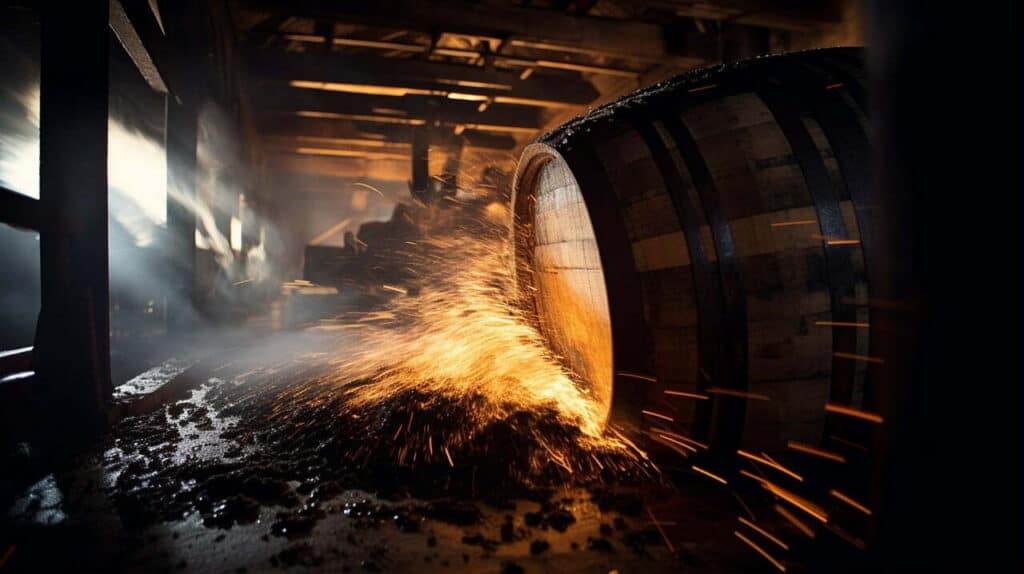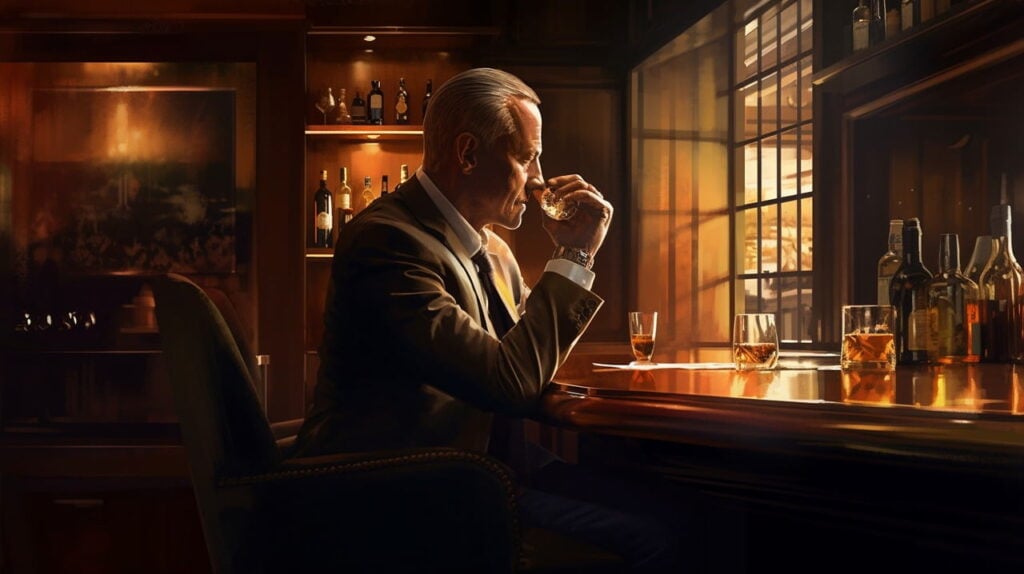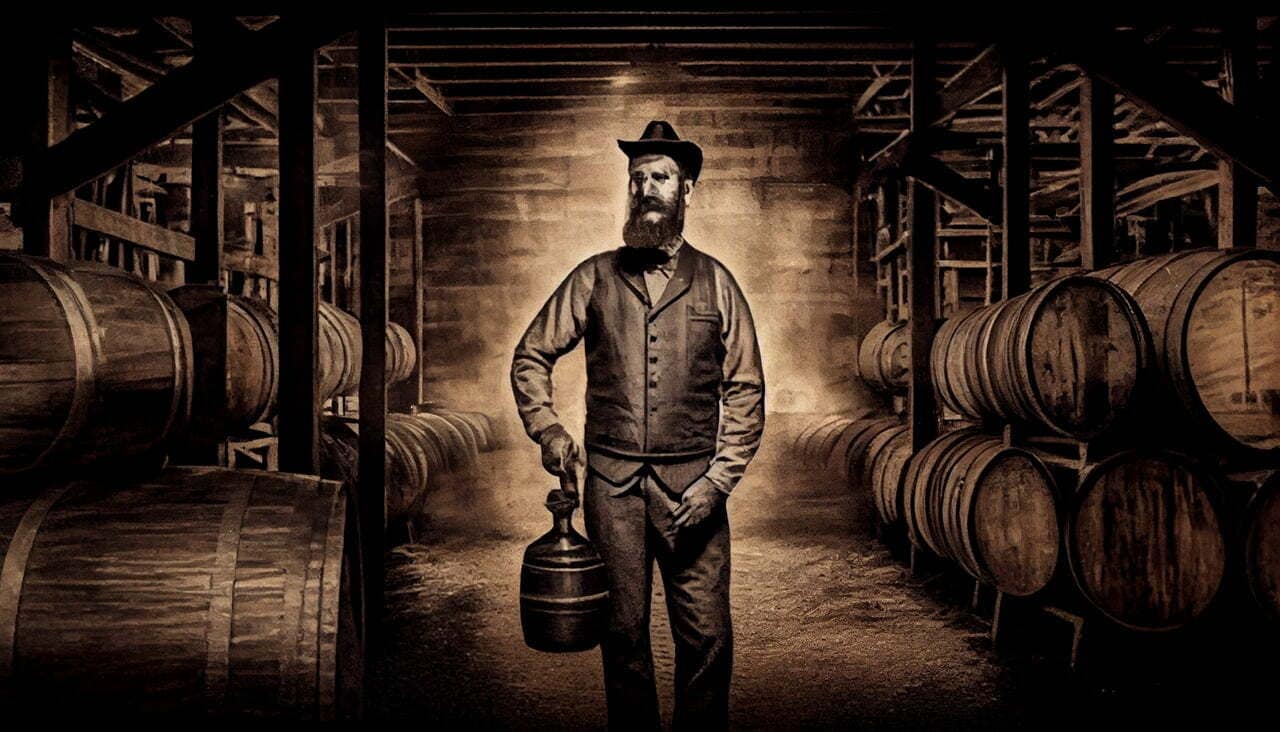Welcome, bourbon enthusiasts! We’re here to take you on a spirited journey through the rich and captivating history of America’s favorite whiskey – bourbon. From its humble beginnings in Kentucky’s rolling hills to its global rise as an iconic American beverage, there’s no denying the impact and allure that bourbon has had throughout the years.
So grab your favorite glass of this amber-hued elixir and join us as we uncover the fascinating origins, pivotal moments, and unforgettable characters who have shaped the world of bourbon whiskey. Are you ready to delve into centuries-old distilling practices while sipping on some delicious history? Let’s get started!
Table of Contents
The Origins Of Bourbon Whiskey
Bourbon whiskey has a rich history that dates back to the late 18th century, with early developments and influences coming from European settlers who brought their knowledge of distilling practices to America.
Early Developments And Influences
My fascination with bourbon began when I discovered the rich history and diverse influences behind this beloved American spirit. Early distilling practices were brought to the area now known as Kentucky by settlers, including Scots, Scots-Irish, English, Irish, and Welsh, in the late 18th century. They used their expertise from their respective homelands to lay down the foundation for what would later become one of America’s most cherished beverages.
As a bourbon enthusiast myself, I love digging deeper into its humble beginnings to better appreciate each sip of this golden elixir. Bourbon’s unique character can be attributed to factors such as limestone-filtered water sources and abundant corn crops that early-nineteenth-century Kentucky distillers creatively utilized in crafting their whiskey for both home use and market consumption. The marriage between these natural resources laid a solid groundwork for further refining our modern-day bourbon.
Exploring early developments also introduces us to key players like the Beams family, who greatly impacted bourbon production through numerous generations committed to perfecting the art of distillation. Their influence on Bourbon whiskey cannot be overstated – it is a legacy that remains prevalent today through iconic brands carrying on their name and passion for excellence. So let us toast our glasses fondly, remembering Bourbon’s inception while embracing all that has shaped it into being an ever-growing symbol of American culture!
The Role Of Kentucky In Bourbon Production
Kentucky has long been the heart and soul of bourbon production, with its rich history dating back to 1785 when Bourbon County was established. This fertile land in the Bluegrass Region provided the perfect environment for whiskey distillation, thanks to its easily accessible water sources that are naturally filtered through limestone deposits. The abundance of corn made it an ideal base ingredient, ensuring a unique and distinct flavor profile that distinguishes Kentucky bourbon from other types of whiskey.

The development of advanced distilling practices over time transformed Kentucky into an epicenter of world-renowned bourbon manufacturing. Many iconic brands were born in this region, including Maker’s Mark, Jim Beam, Woodford Reserve, Buffalo Trace, and Wild Turkey – all staples at events such as the famous Kentucky Derby. These legendary distilleries have not only perfected their craft but also innovated new techniques in barrel aging and mash bill composition – giving life to small-batch bourbons with varying proofs and flavors.
Moreover, the importance of Kentucky in bourbon production extends beyond just taste or technique; it is deeply rooted within American culture itself. It survived prohibition and economic hardships like the Whiskey Rebellion while still thriving during times of prosperity, such as during today’s Bourbon boom period. As more whiskey enthusiasts across America explore this compelling centuries-old spirit on the much-celebrated Kentucky Bourbon Trail tourism circuit], they can truly appreciate how pivotal a role this region played – so deeply intertwined with pride and passion – in developing one beloved sip after another throughout history!
The Growth, Decline, And Revival Of Bourbon Whiskey
Prohibition brought the bourbon industry to a standstill, but the revival of craft distilleries in the 1980s and growing global demand have put bourbon back on top – keep reading to uncover how this iconic American whiskey made its comeback.
The Impact Of Prohibition
Prohibition was a dark period in American history, and it had a major impact on the bourbon industry. Between 1920 and 1933, the production and sale of alcohol were banned nationwide. This forced most whiskey distilleries to close their doors, leading to a steep decline in the production of bourbon whiskey.

During Prohibition, many Americans turned to bootlegging or illegally-produced spirits as an alternative. This led to various issues such as increased crime rates, public health concerns due to unregulated alcohol production, and loss of tax revenue for the government. It also set back bourbon production considerably since most distilleries had to completely rebuild after being shut down for so long.
The Revival Of Bourbon In The 1980s And Beyond
As a bourbon enthusiast, I cannot help but be grateful for the revival of bourbon in the 1980s and beyond. After Prohibition and World War II, bourbon whiskey was not as popular as it once was. However, there were still several distilleries that continued to make this delicious spirit. It wasn’t until the 1980s that renewed interest in craft distilling led to a resurgence of appreciation for quality bourbons.

Thanks to the efforts of visionary entrepreneurs such as Bill Samuels Jr., Bourbon County Distilling Company (now Maker’s Mark) started producing their iconic red wax-sealed bottles with their smooth-tasting wheated mash bill, which is still wildly popular to this day. Wild Turkey’s Jimmy Russell continued his legacy with award-winning expressions like Rare Breed and Kentucky Spirit while Booker Noe of Jim Beam fame released Booker’s – an unfiltered barrel-strength offering that has become a staple on many connoisseurs’ shelves. These trailblazers paved the way for future generations of master distillers who continue to create unique variations within traditional barrel-aged spirits like bourbon whiskey today.
In conclusion, I believe that without this renewed interest in quality craftsmanship, we might have missed out on many fantastic expressions from some of our favorite brands over the past few decades—making it all worth raising a glass!
The Bourbon-Making Process
The bourbon-making process involves carefully selecting the right mash bill, distilling the mixture, aging it in new charred oak barrels for a specific period of time, and determining the proof to create a unique and flavorful spirit.
Ingredients And Recipe Variations
When it comes to making bourbon whiskey, the ingredients used and their ratios can vary from distillery to distillery. However, corn is always a key ingredient in the mash bill. Most bourbons contain at least 51% corn, while some use as much as 80%. Furthermore, bourbon makers often use varying amounts of barley and rye to give their spirits unique flavors.
Another factor that sets bourbon apart from other whiskeys is its reliance on new oak barrels for aging. By law, these barrels must be charred inside before being filled with bourbon. This charring process imparts additional flavors and aromas into the whiskey as it ages. Additionally, most brands age their bourbons between four and twelve years before bottling them for sale. All of these factors contribute to the distinct flavor profile that makes each bottle of bourbon unique!
Distillation And Aging In Barrels
As a bourbon enthusiast, you know that the distillation and aging process is what gives bourbon its unique flavor profile. Here are some important things to know about this essential step in producing bourbon:
- Bourbon must be distilled at no more than 160 proof, or 80% alcohol by volume.
- After distillation, the clear liquor is placed into new charred oak barrels for aging.
- The barrel’s charred interior filters out impurities and adds flavors through a process called “wood maturation.”
- During the aging process, the whiskey interacts with the barrel’s wood sugars and other compounds, such as phenols and tannins.
- Many factors affect how long a bourbon will age in a barrel, including temperature, humidity, and storage location within the warehouse.
- Bourbon must be aged for at least two years to be considered “straight” bourbon.
Remember, each step in making bourbon is crucial to achieving that perfect taste we all know and love.
The Significance Of Barrel Char And Proof
Bourbon gets its unique flavor from aging the whiskey in a charred barrel. The charring process caramelizes sugars in the wood and gives bourbon its distinctive smoky taste. This process also affects the proof of bourbon, which refers to the percentage of alcohol in the final product. Most bourbons are bottled at 80-100 proof, but some can be as high as 140 proof or more.
Barrel char is an important factor that influences not only the taste but also the color and aroma of bourbon. Bourbon makers use different levels of char on their barrels to create nuanced flavors, such as vanilla, cinnamon, and oak spice notes. Additionally, using new charred oak barrels for each batch enhances oxidation which adds complexity and depth to flavor profiles over time. These factors combine to make barrel char and proof vital components of creating exceptional-tasting bourbon whiskies that stand out among their peers on store shelves across America today!
The Legacy And Significance Of Bourbon Whiskey
Bourbon whiskey has left an indelible mark on America’s cultural and economic history; from iconic brands like Jim Beam and Maker’s Mark to the Kentucky Derby’s famous mint julep, bourbon continues to be a symbol of American heritage that brings people together.
Iconic Brands And Their Histories
As a bourbon enthusiast, I know that the history of iconic brands and their stories are fascinating. Here are some highlights:
- Jim Beam: Founded in 1795, this brand is one of the oldest and most well-known bourbon makers in the world. The Beam family has kept the recipe unchanged for over 200 years, staying true to their roots.
- Maker’s Mark: This Kentucky-based distillery was founded in 1953 by Bill Samuels Sr., who wanted to create a smooth and approachable bourbon. Its trademark red wax seal is instantly recognizable.
- Wild Turkey: Originating in 1940 with master distiller Jimmy Russell, Wild Turkey has become a household name thanks to its distinctive flavors and bold branding.
- Four Roses: This Kentucky-based brand dates back to the late 1800s and relies on a unique combination of two mash bills and five proprietary yeast strains to create its signature flavor profile.
- Old Rip Van Winkle: A family-operated business since 1893, this brand uses only the finest ingredients in its production process and is known for its rare and highly sought-after bottlings.
- Buffalo Trace: With roots tracing back to the early 1800s, Buffalo Trace produces some of the most awarded bourbons on the market today. Its flagship product, Blanton’s Single Barrel Bourbon, has achieved cult status among collectors.
- Woodford Reserve: Founded in 1812 as a working farm, Woodford Reserve combines traditional methods with modern technology to create premium bourbons beloved by enthusiasts around the world.
- Pappy Van Winkle’s Family Reserve: A top pick among serious bourbon aficionados, this iconic brand has been producing quality bourbon since before Prohibition, with prideful craftsmanship dating back nearly two centuries ago.
These brands represent just a few of the many incredible bourbons that have helped shape America’s booming whiskey industry throughout history.
The Cultural And Economic Impact Of Bourbon On American History
As a bourbon enthusiast, it is impossible to overlook this iconic American whiskey’s significant cultural and economic impact throughout history. Bourbon has played an instrumental role in shaping the country’s identity, from its origins in 18th-century Kentucky to its current global popularity. It has been at the forefront of many historic events, with pro-bourbon slogans such as “Vote for Whiskey! You are better off with your friends than your enemies” being coined during times of political unrest.
The economic benefits of bourbon production cannot be overstated either. The industry currently employs over 20,000 individuals in Kentucky alone and generates billions in annual revenue for both smaller craft distilleries and larger corporations. In addition to providing jobs and boosting local economies, bourbon tourism continues to grow each year – particularly along the famous Kentucky Bourbon Trail that allows visitors to tour some of America’s most well-known distilleries.
Moreover, bourbon’s cultural significance extends beyond just economics. The drink has been immortalized on film through American classics like “Gone with the Wind” and “Cat on a Hot Tin Roof,” while also making appearances at prestigious events such as the Kentucky Derby. Its rich history is revered by enthusiasts around the world who appreciate its deep connection with America’s past and ongoing influence upon present culture alike.
The Kentucky Bourbon Trail And Bourbon Tourism
As a bourbon enthusiast, one of the top experiences on my bucket list is exploring the Kentucky Bourbon Trail. Established in 1999 by the Kentucky Distillers’ Association, this iconic trail takes visitors on a journey through some of the best distilleries in America’s whiskey heartland. From Maker’s Mark to Jim Beam and Wild Turkey, there are plenty of big-name brands to explore – but don’t miss out on smaller craft distilleries like Willett and Town Branch.
Bourbon tourism is big business for the Bluegrass State, welcoming more than a million tourists each year. And it’s not just about sipping delicious whiskey; visitors can also learn about bourbon history and production techniques and even dine at distillery restaurants that feature locally sourced ingredients. If you’re planning your own trip along the Kentucky Bourbon Trail, consider booking a dedicated tour or creating your itinerary based on what type of bourbons you enjoy most.
Overall, the Kentucky Bourbon Trail offers an unforgettable experience for those who want to immerse themselves in American whiskey culture. With so many great distilleries to choose from and no shortage of things to see and do along the way (including visiting nearby horse farms), it’s no wonder why this trail has become such an important part of bourbon history – both past and present!
The Future Of Bourbon Whiskey
The future of bourbon whiskey is bright, with increasing popularity and global demand driving innovation and experimentation in the industry.

Innovation And Experimentation
One of the most exciting aspects of bourbon whiskey is the constant innovation and experimentation happening within the industry. From unique mash bills to experimental barrel aging techniques, distillers are always pushing the limits in search of new flavors and experiences. It’s this spirit of exploration that has led to some truly phenomenal bourbons hitting shelves in recent years.
But while innovation is certainly important, it’s also essential for distillers to stay true to their roots. After all, bourbon has a long and storied history dating back centuries, and there’s something truly special about sipping on a glass that honors those traditions while still bringing something new to the table. Whether you’re a die-hard traditionalist or an adventurous experimenter, there’s no denying that bourbon whiskey offers something truly unique for drinkers everywhere.
Increasing Popularity And Global Demand
As a bourbon enthusiast, it’s no surprise that you’ve noticed the recent surge in popularity of this beloved American spirit. In fact, global demand for bourbon has been on an upward trend over the past few years. This rise can be attributed to a variety of factors, from increased interest in craft spirits to growing consumer appreciation for premium products.
Premium bourbons are particularly sought-after these days, with some bottles selling for hundreds or even thousands of dollars due to their rarity and age. And despite facing challenges like retaliatory tariffs, bourbon tourism remains a bright spot for the industry as people continue to seek out unique distilleries and experiences along the Kentucky Bourbon Trail and beyond. Overall, it’s clear that bourbon has firmly cemented its place among the world’s most popular distilled spirits – and as fans ourselves, we couldn’t be happier about it!
The Role Of Technology In Bourbon Production
Technology has played an increasingly pivotal role in the production of bourbon whiskey. Bourbon makers today are utilizing innovative technologies such as IoT sensors, cloud computing, and data analytics to enhance the efficiency of their businesses. For instance, at Peerless Distillery based in Kentucky, Caleb Kilburn and his family-run business have embraced technology to manage their data efficiently while also automating many aspects of their production process.
In addition to automation and data management systems, new technologies can also help distilleries blend ingredients more precisely to create a specific flavor profile for each batch of bourbon created. Automated blending technology enables producers to determine exactly how much rye or corn they want in each barrel and mix it accordingly with automated precision.
As new generations come up with fresh perspectives on this traditional industry, we’re likely to continue seeing modern tech incorporated into bourbon-making techniques. While these innovations will undoubtedly bring changes, the overall commitment remains the same: ensuring that every batch produced is consistent in quality creating classic sipping whiskey that customers can expect time after time!
Conclusion
In conclusion, the history of bourbon whiskey is a fascinating tale that has evolved over time. From its early developments and influences to its growth, decline, and revival, bourbon has played an essential role in American culture and economy for centuries.
The iconic brands and their distinct histories have made it a beloved drink among enthusiasts worldwide. As we look towards the future, innovation and experimentation, continue to push the boundaries of what defines bourbon whiskey as distillers strive to appeal to new audiences while still respecting tradition. Whether enjoyed neat or mixed into cocktails, one thing remains clear- bourbon whiskey is here to stay!
Frequently Asked Questions
What is the history of bourbon whiskey?
Bourbon whiskey has a rich history that dates back to the late 18th century when settlers in Kentucky began distilling corn-based spirits in copper stills. Over time, bourbon became synonymous with American culture and tradition, and many famous brands emerged as popularity grew.
What distinguishes bourbon from other types of whiskey?
Bourbon is unique due to its specific production requirements, which mandate that it must be made from at least 51% corn and aged in new oak barrels for at least two years. These restrictions ensure that the final product has a distinct flavor profile and aroma compared to other varieties of whiskey.
How can I best experience bourbon tasting?
To get the most out of your bourbon tasting experience, start by selecting a high-quality bottle that fits within your budget range. Take small sips rather than large gulps to savor the flavors on your palate, and experiment with various combinations, such as pairing with food or adding ice or water to dilute or enhance certain flavors.


